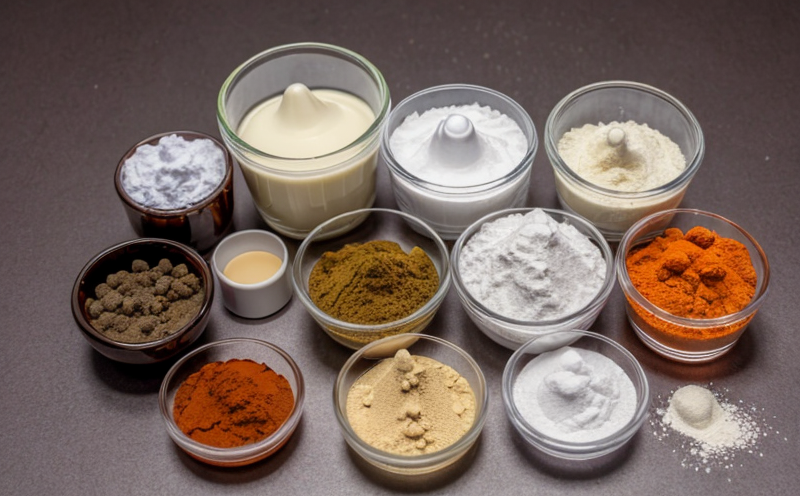HPLC UV Identification Testing
In the pharmaceutical industry, excipients and formulation ingredients play a crucial role in ensuring drug stability, efficacy, and safety. High-Performance Liquid Chromatography (HPLC) coupled with Ultraviolet (UV) detection is an essential analytical technique used to identify and quantify excipients and other formulation components accurately. This method ensures that the correct materials are being used in compliance with regulatory standards.
The primary purpose of HPLC UV identification testing involves separating, quantifying, and identifying compounds based on their retention times and characteristic peaks observed under UV detection. The process begins by preparing a sample solution from the excipient or formulation ingredient. This preparation often includes dissolving the substance in an appropriate solvent that does not interfere with the chromatographic separation.
Once prepared, the sample is injected into the HPLC instrument. As it passes through the column, individual components are separated based on their interactions with the stationary phase and mobile phase. The UV detector measures the absorbance of each component at a specific wavelength (typically 254 nm or another suitable wavelength for the compound being analyzed). These measurements are then used to create a chromatogram.
The retention time, peak area, and other parameters derived from this process help in identifying the excipient or formulation ingredient. This identification is critical because it ensures that only approved substances are used in drug formulations, preventing potential contamination issues. Regulatory compliance becomes easier when all ingredients can be accurately identified using standardized methods like those specified by ISO standards.
The precision and accuracy of HPLC UV testing make it a preferred choice for pharmaceutical quality assurance departments responsible for ensuring product integrity throughout the supply chain. By leveraging this technology, companies can maintain consistent product quality while adhering to stringent regulatory requirements such as FDA guidelines or EU directives.
In summary, HPLC UV identification testing is vital for verifying that the correct excipients and formulation ingredients are being used in drug products. It supports compliance with international standards like ISO 17764:2015, which provides a framework for good laboratory practices.
Why Choose This Test
HPLC UV identification testing offers several advantages over other analytical techniques when it comes to identifying and validating excipients and formulation ingredients:
- Precision and Accuracy: The high degree of precision allows for accurate quantification even at very low concentrations.
- Speedy Results: Modern HPLC systems can provide results relatively quickly, reducing turnaround times significantly compared to alternative methods.
- Wide Range of Applications: This technique is versatile and applicable across various types of excipients and formulations.
- Regulatory Compliance: It aligns perfectly with international standards like ISO 17764:2015, ensuring that all tests meet strict quality control criteria.
The combination of these factors makes HPLC UV identification testing an indispensable tool for maintaining high standards in pharmaceutical manufacturing processes. Whether you're a small startup or a large multinational corporation, investing in this technology can significantly enhance your ability to produce safe and effective medications compliant with global regulations.
Environmental and Sustainability Contributions
The use of HPLC UV identification testing contributes positively to environmental sustainability efforts within the pharmaceutical industry. By ensuring that only the correct excipients are used in drug formulations, this method helps prevent waste associated with incorrect ingredient usage or contamination incidents.
Additionally, by adhering strictly to ISO standards and other relevant regulations, laboratories conducting HPLC UV identification testing contribute towards minimizing environmental impact through proper disposal practices and reduced resource consumption. The precision of the technique ensures that no unnecessary quantities of raw materials are wasted during preparation stages.
Furthermore, by maintaining stringent quality controls throughout production processes, pharmaceutical manufacturers can reduce their ecological footprint. This includes reducing energy usage due to optimized manufacturing procedures based on accurate ingredient identification.
In conclusion, HPLC UV identification testing plays a significant role in promoting environmental responsibility within the pharmaceutical sector. It supports sustainable practices that benefit both the company and society at large by ensuring product integrity while minimizing potential negative impacts on the environment.
Competitive Advantage and Market Impact
HPLC UV identification testing provides a competitive edge in several ways:
- Innovation Leadership: By staying ahead of regulatory changes and technological advancements, organizations utilizing this method can introduce new formulations faster than competitors.
- Better Decision-Making: Accurate data from HPLC UV tests enable better informed decisions regarding ingredient selection and process optimization.
- Customer Trust: Demonstrating commitment to quality through rigorous testing builds trust among customers, leading to increased loyalty and market share.
- Cost Efficiency: While initial investment may seem high, long-term savings come from reduced errors and reworks associated with incorrect ingredient use or contamination issues.
In competitive markets where product differentiation is key, HPLC UV identification testing can be a decisive factor. It not only enhances operational efficiency but also fosters innovation and customer confidence, ultimately driving business growth and profitability.





